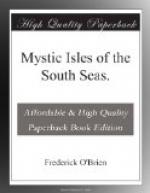A Swiss with a letter of introduction to me presented it when seven days out. It was from the manager of a restaurant in San Francisco, and asked me to guide him in any way I could. The Swiss was middle-aged, and talked only of a raw diet. He was to go to the Marquesas to eat raw food. One would have thought a crude diet to be in itself an end in life. He spoke of it proudly and earnestly, as if cooking one’s edibles were a crime or a vile thing. He told me for hours his dictums—no alcohol, no tobacco, no meat, no fish; merely raw fruit, nuts, and vegetables. He was a convinced rebel against any fire for food, making known to any one who would listen that man had erred sadly, thousands of years ago, in bringing fire into his cave for cooking, and that the only cure for civilization’s evils was in abolishing the kitchen. He would live in the Marquesas as he said the aborigines do. Alas! I did not tell him they ate only their fish raw.
Ben Fuller, the Australian theatrical manager, frowned on him. Fuller was as round as a barrel, and he also was certain of the remedies for a sick world.
“How you ‘re goin’ a get any bloody fun with no roast beef, no mutton, no puddin’, and let alone a drop of ale and a pipe?”
The Swiss smiled beatifically.
“You can get rid of all those desires,” he said.
“My Gawd! I don’t want to get rid o’ them, I don’t. I’m bringing up my kiddies right, and I’m a proper family man, but I want my meat and my bread and my puddin’. The world needs proper entertainment; that’s what’ll cure the troubles.”
The Swiss was also ardent in attention to the women aboard, and I wondered if there was a new school of self-denial. The old celibate monks eschewed women, but had Gargantuan appetites, which they satisfied with meat pasties, tubs of ale, and vats of wine.
There were two Tahitians aboard, both females. One was an oldish woman, ugly and waspish. She counted her beads and spoke to me in French of the consolations of the Catholic religion. She had been to America for an operation, but despaired of ever being well, and so was melancholy and devout. I talked to her about Tahiti, that island which the young Darwin wrote, “must forever remain classical to the voyager in the South Seas,” and which, since I had read “Rarahu” as a boy, had fascinated me and drawn me to it. She warned me.
“Prenez-garde vous, monsieur!” she said. “There are evils there, but I am ashamed of my people.”
The other was about twenty-two years old, slender, kohl-eyed, and black-tressed. She was dressed in the gayest colors of bourgeois fashion in San Francisco, with jade ear-rings and diamond ornaments. Her face was of a lemon-cream hue, with dark shadows under her long-lashed eyes. Her form was singularly svelt, curving, suggestive of the rounded stalk of a young cocoa-palm, her bosom molded in a voluptuous reserve. Her father, a clergyman, had cornered the vanilla-bean market in Tahiti, and she was bringing an automobile and a phonograph to her home, a village in the middle of Tahiti.




